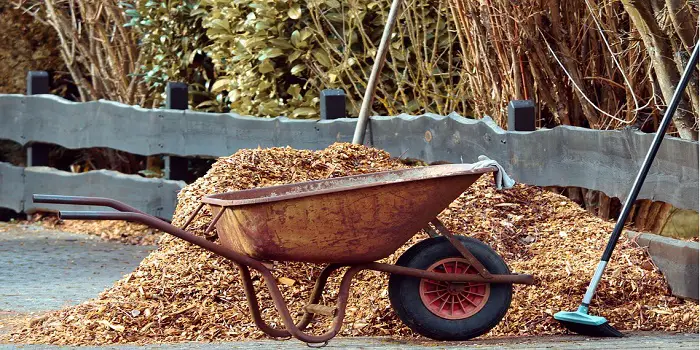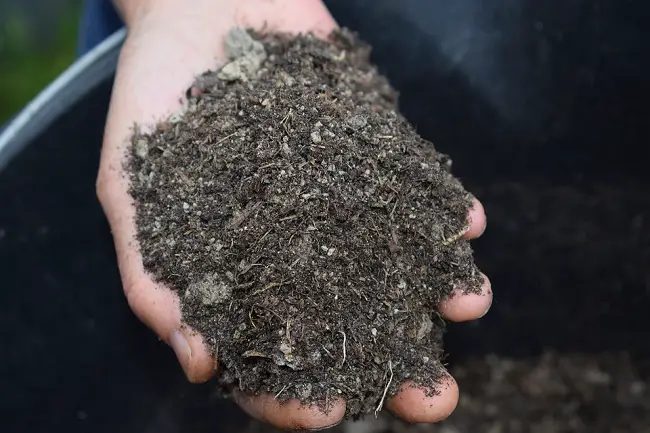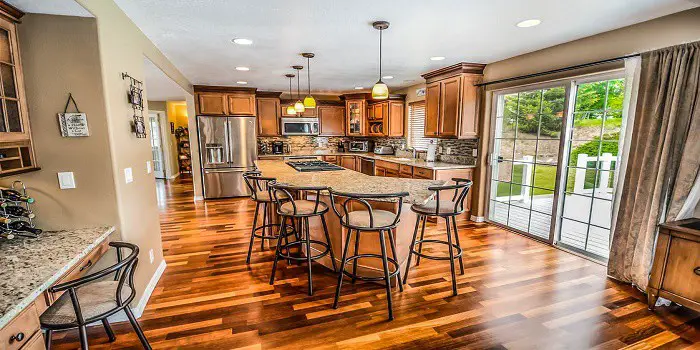
Bark mulch is the stock standard material used to cover gardens to create a better aesthetic.
It also provides other benefits such as fighting off weeds, keeping moisture from escaping, providing insulation to your plants during colder months, keeping your topsoil in good condition, and it becomes food for your plants as it decomposes.
One major factor, however, you should consider is that mulch is combustible and can become highly flammable during dryer months.
Some of the alternatives below are excellent options so that you don’t have any accidental fires raging in your gardens.
These may have different aesthetics, are cheaper, or are even more environmentally friendly.
Least Flammable Mulch Alternatives
1. Pea Gravel
Pea gravel is a fantastic alternative to mulch. It has the same benefits, such as restricting weed growth and keeping moisture in your garden.
In addition, it’s not going to decompose like mulch and many other alternatives, so it requires very minimal maintenance.
It’s also a very cheap material to have delivered and layout in your garden yourself.
The other significant benefit of pea gravel is that gravel can’t catch fire, so during the dry season, and if fires are a big issue in your area, then pea gravel is a much better option.
What you’ll also find is that pea gravel is incredibly aesthetically pleasing when placed around your garden and plants.
It’s a smooth, pea-sized pebble that comes in various colors, such as buff, brown, gray, white, and even translucent.
It’s also much easier to walk on, and water will easily drain through it into the ground below.
One thing to consider with pea gravel is that it can travel. So having edging or something to contain the pea gravel would be needed.
However, that’s minimal cost and effort, considering you won’t need to spend time replacing or maintaining it in the future.
2. Lava (Pumice) Rocks
Lava rock is another fantastic option when you don’t want to deal with the maintenance of bark mulch.
It can cost double per bag but consider that bark mulch needs to be replaced at least once a year, if not twice.
So you pay a little extra, to begin with, but have significant cost savings each year.
It does depend on your taste, but lava rocks are aesthetically pleasing.
Because they’re not decomposing, you keep the same look year-round.
You can decide what color you want, but generally, you can get black, grey, brown, metallic silver, pink, and even green.
So, you have a lot of interesting colors that you can even mix or put in different areas for a more interesting look.
Lava rocks provide excellent temperature control and moisture retention for your plants.
Be careful of using black lava rocks in very hot areas, though, as they can overheat your plants.
The advantage for hot or dry regions is that lava rocks will not catch fire, so they are much safer where there are significant fire hazards during the year.
3. Wood Chip Mulch
You may be thinking that bark mulch and wood chip mulch is basically the same things. However, they act very differently.
While bark and wood chip mulch look very similar, wood chip mulch is much more fire-resistant, so it is an excellent choice when you want the natural wood look but lives in a fire-prone area.
The key to being more fire-resistant is to ensure the underlying area is well irrigated and then layer wood chip mulch on top.
The wood chip will absorb water and keep your plants healthy.
A well-irrigated area with healthy lush plants will be much more difficult to catch fire, as will the wet wood chip mulch not burning very easily.
Wood chipping mulch also has the standard benefits you get with most mulch.
It keeps pests away, has excellent temperature control, and controls weeds that try to enter your garden.
4. Compost
Compost is another excellent option for keeping the fire away from your home.
While it isn’t as aesthetically pleasing as other options, it’s a fantastic choice for behind your house, in large gardens, or in even more rural areas.
When you put compost in your garden, it not only assists with fire resistance but it’s an excellent source of food for your plants which will maintain moisture and stop soil erosion.
If your plants are not getting enough nutrients from the soil, then compost is the perfect solution to help.
Compost can be made of many different materials, some using manure and others not.
You can even get composted wood chips, which we know are already excellent fire-resistant material.
If the smell of compost is an issue for you, simply stay away from the manure varieties.

Mulch Alternatives with Limited Combustibility
The mulch alternatives above are your best option when a fire is a significant risk in your area, especially when the garden is close to your home or other structures.
However, there is a time and place for other mulch alternatives, but you’ll need to assess the risk.
A significant factor in limiting the combustibility of other mulch alternatives is keeping good irrigation; this keeps the mulch moist, which makes it harder for them to catch fire.
But this is not a guaranteed method for fire resistance around your home, and it’s simply an option if you need to use bark mulch or other organic mulch.
Listed below are some other popular mulch alternatives for you to consider and assess if they are good options for your environment.
5. Cocoa Bean Hulls
Cocoa bean hulls may not be your first thought for an alternative to mulch.
Still, they have an excellent aesthetic, a sweet aroma, and even retain moisture for your plants.
However, they can attract pests and constitute a significant health risk for your pets.
They are one of the most fire-resistant organic materials you can use.
However, they’re not listed in the main section due to the risk to pets like your dogs.
Which, personally, I find unacceptable.
6. Rubber Mulch
Rubber mulch is made up of ground-up tires; it’s long-lasting and doesn’t need to be replaced.
It is a great option where insects are a big issue for your plants and for ground covers.
The two critical issues with rubber mulch are that it could be very toxic and it’s one of the most combustible materials on the list.
Not only is it combustible, but it burns the hottest and will certainly waft through the air, so it is not ideal near buildings.
7. Leaves
A cheap option is using leaves as mulch.
They should be shredded and dried before placing them in your garden, and you want about 2-3 inches worth of leaves to make it worthwhile.
They will decompose, so you need to keep topping up your supply, but they provide excellent nutrients to the plants and maintain moisture.
Leaves are incredibly combustible, and any hint of fire will have your garden up in flames quickly.
Therefore, they are not a great option in fire-prone areas.
8. Grass Clippings
Grass clippings are another very cheap alternative for mulch around your garden.
Much easier to get than some of the other cheap organic materials on the list.
Simply mow your lawn with a grass catcher and ensure that your grass is dried before placing it in the garden.
The grass clippings are an excellent source of nutrition for your plants and provide moisture retention.
However, while they’re free, they are time-consuming and have the same issue as leaves in that grass clippings will readily catch fire and can even spread, so they are not a good option for fire-prone areas.
9. Pine Needles
If you live in an area with many pine trees and can collect pine needles, they’re a great free option for mulch in your garden.
You can use fresh or dried, depending on what you like, and they’re a more aesthetically pleasing option than leaves or grass clippings.
Pine needles have a very similar issue as many organic materials; especially when dried, they will catch fire exceptionally quickly and spread easily.
Do not use them around your home.
10. Hay or Straw
If you live on a farm or have access to cheap hay or straw, then it’s a great option to use as mulch in your gardens.
It decomposes and provides excellent nutrition to your plants, maintains moisture, and even keeps weeds away.
What it doesn’t do is keep pests away. Rodents, snakes, and many other animals lost to burrow into hay or straw and make it their home.
So, it’s not an ideal option unless you don’t mind this.
It’s also going to be highly combustible, so it is not suitable for fire-prone areas.
FAQs
Do You Really Need Mulch?
In short, mulch is a must for any gardener or farmer interested in optimizing their soil health.
Mulch is a layer of protective material, typically organic that you spread over the surface of your soil. It can be anything from compost or shredded leaves to wood chips or straw.
Mulch has many benefits for your soil and plants, including:
- Regulating soil temperature
- Reducing evaporation
- Preventing erosion
- Suppressing weed growth
- Improving soil fertility
- Supporting healthy microbial activity
How often you need to replace the mulch will depend on the type of mulch you’re using and the conditions of your soil and climate.
In general, you should apply a fresh layer of mulch every 1-2 years.
Are There Risks to Applying Too Much Mulch?
Yes, there are risks to applying too much mulch. If you apply a thick layer of mulch, it can:
- Block sunlight and air from reaching the soil
- Prevent water from reaching the roots of plants
- Encourage the growth of mold and fungus
What are the Safe Mulch Alternatives for My Dogs?
If your dog eats mulch, it may experience digestive issues such as vomiting or diarrhea.
But worry not; there are many safe mulch alternatives for dogs, such as:
- Shredded newspapers
- Straw
- Pine needles
- Coconut coir
- Bark chips
- Gravel
If you’re still concerned, please contact your veterinarian to know the right materials you can use.
Final Thoughts
If bark mulch dries and catches fire, it can waft into the air and spread to your home.
These are also expensive materials that need to be replaced and maintained often.
Many substitutes to mulch that I discussed above provide similar benefits and different aesthetics. Plus, they are often cheaper or easier to maintain.
Why not pick the best alternatives that you can use around trees, get creative, and make your garden look different than everybody else’s?

Hi, I am Mark Garner a professional carpenter, woodworker, and DIY painter. I live in the small city of Peoria, Arizona as a semi-retired woodworker. I have started this blog with a simple motive to help you with my wood experience in this sector. If you like to know more about what I love doing and how it all got started, you can check more about me here.





